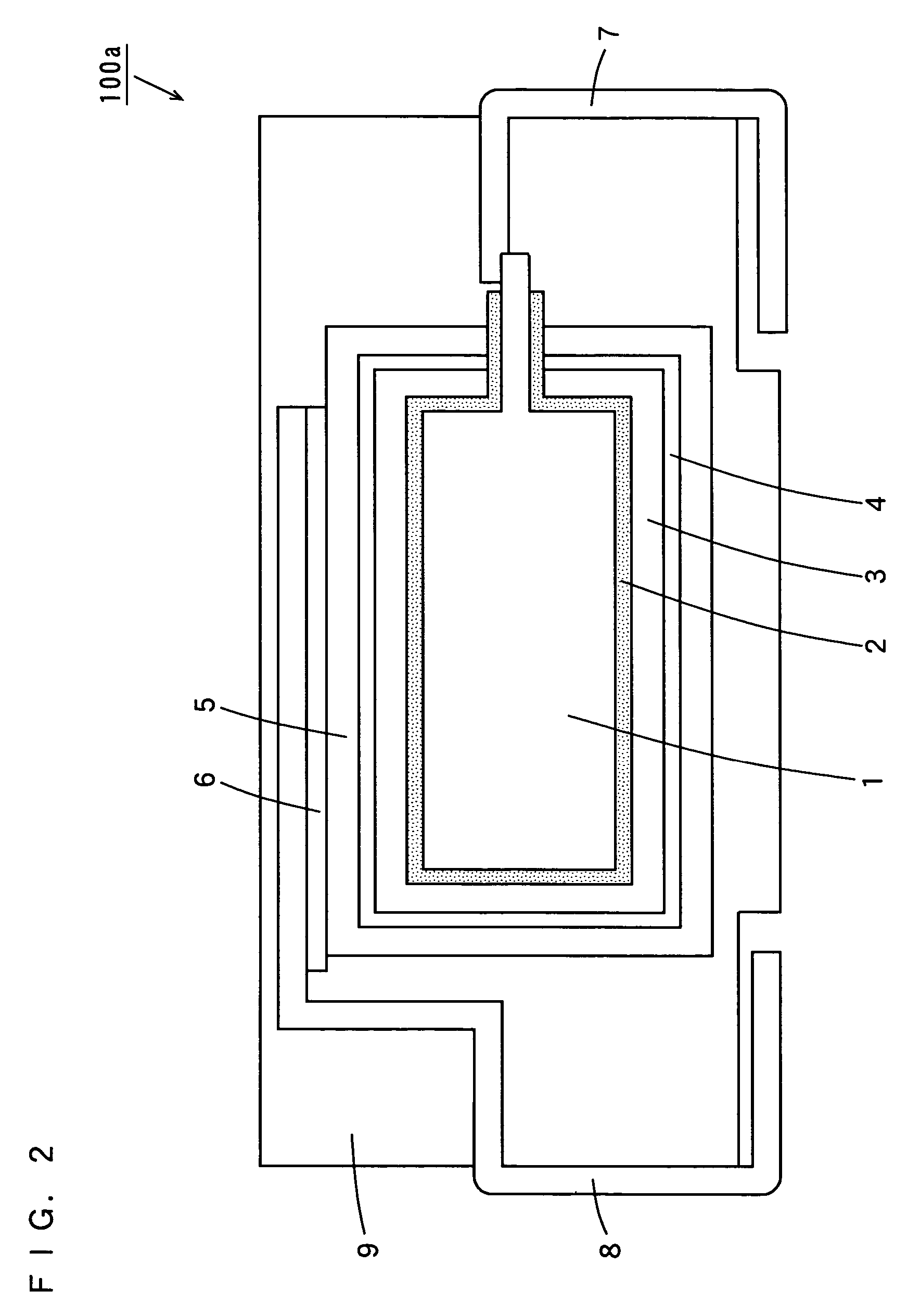Solid electrolytic capacitor and manufacturing method thereof
a technology of solid electrolytic capacitors and manufacturing methods, which is applied in the manufacture of electrolytic capacitors, liquid electrolytic capacitors, electrolytic capacitors, etc., can solve the problems of insufficient leakage current reduction, more likely to be caused by dielectric layers, etc., and achieve the effect of reducing leakage curren
- Summary
- Abstract
- Description
- Claims
- Application Information
AI Technical Summary
Benefits of technology
Problems solved by technology
Method used
Image
Examples
##ventive example 1
Inventive Example 1
[0063]In Inventive Example 1, a solid electrolytic capacitor as shown in FIG. 3 was prepared by the following method.
[0064](Oxidizing Step 1)
[0065]A niobium film as thick as 0.1 mm was used as a niobium substrate 1a. The niobium substrate 1a was allowed to stand for 30 minutes for oxidization in a 0.5 wt % phosphoric acid aqueous-solution maintained at 60° C. at a constant voltage of 45 V, and a dielectric layer 2 composed of niobium oxide was formed on the surface of the niobium substrate 1a.
[0066](Nitriding Step)
[0067]Now, the niobium substrate 1a having the dielectric layer 2 formed thereon was allowed to stand in an electric furnace maintained at 600° C. and 0.1 atmospheric pressure for five minutes. In this way, a niobium nitride layer 1b was formed between the niobium substrate 1a and the dielectric layer 2.
[0068](Oxidizing Step 2)
[0069]The niobium substrate 1a was oxidized again in a 0.5 wt % phosphoric acid aqueous solution maintained at 60° C. In this wa...
##ventive examples 2 to 15
Inventive Examples 2 to 15
[0090]In Inventive Examples 2 to 15, the correlation between the nitrogen content and leakage current was examined.
[0091]Here, in Inventive Examples 2 to 15, the treatment temperature in the nitriding step in the process of preparing a capacitor in Inventive Example 1 was changed in the range from 120° C. to 1000° C. The treatment temperatures in the nitriding step in Inventive Examples 2 to 15 were 120° C., 200° C., 250° C., 300° C., 600° C., 700° C., 800° C., 850° C., 870° C., 900° C., 920° C., 940° C., 970° C., and 1000° C., respectively. The other conditions were the same as those of Inventive Example 1. Note that the capacitor in Inventive Example 6 was the same as the capacitor prepared in Inventive Example 1.
[0092](Evaluation)
[0093]For the capacitors in Inventive Examples 2 to 15, the nitrogen content, leakage current, and compounds identified by X-ray powder method are given in Table 2.
[0094]Note that the respective the leakage current measurement r...
##ventive example 16
Inventive Example 16
[0101]In Inventive Example 16, a solid electrolytic capacitor shown in FIG. 2 was prepared by the following method.
[0102](Step of Producing Niobium Powder)
[0103]Niobium powder having an average particle size of 1 μm was thermally treated for one hour in a nitrogen atmosphere at 1000° C. and 0.1 atmospheric pressure.
[0104](Step of Producing Niobium Nitride)
[0105]The thermally treated niobium powder was sintered and formed into an anode 1 composed of niobium nitride.
[0106](Oxidizing Step)
[0107]The anode 1 was then oxidized for 10 hours in a 0.5 wt % phosphoric acid aqueous solution maintained at 60° C. at a constant voltage of 10 V, and a dielectric layer 2 composed of niobium oxide was formed on the surface of the anode 1.
[0108](Step of Producing Solid Electrolytic Capacitor)
[0109]The dielectric layer 2 had its surface coated with a conductive polymer layer 3 composed of polypyrrole by electrolytic polymerization. In this case, the conductive polymer layer 3 was f...
PUM
| Property | Measurement | Unit |
|---|---|---|
| temperature | aaaaa | aaaaa |
| temperature | aaaaa | aaaaa |
| constant voltage | aaaaa | aaaaa |
Abstract
Description
Claims
Application Information
 Login to View More
Login to View More - R&D
- Intellectual Property
- Life Sciences
- Materials
- Tech Scout
- Unparalleled Data Quality
- Higher Quality Content
- 60% Fewer Hallucinations
Browse by: Latest US Patents, China's latest patents, Technical Efficacy Thesaurus, Application Domain, Technology Topic, Popular Technical Reports.
© 2025 PatSnap. All rights reserved.Legal|Privacy policy|Modern Slavery Act Transparency Statement|Sitemap|About US| Contact US: help@patsnap.com



